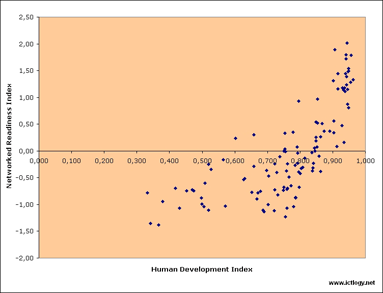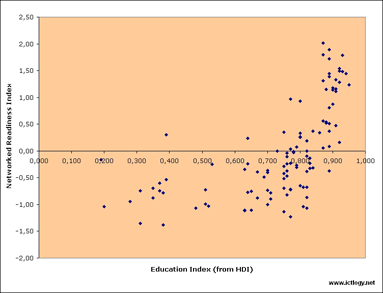By Ismael Peña-López (@ictlogist), 27 April 2006
Main categories: Connectivity, e-Readiness, Hardware, ICT4D
No Comments »
The Economist Intelligence Unit 2006 e-readiness rankings have been published: the world in early 2006 may be proclaimed ever more “e-ready”. This year’s e-readiness rankings reflect such progress, as all but two countries have improved their scores from the previous year
.
I absolutely disagree with this following statement: Just as encouraging is the apparent narrowing of the “digital divide” in some facets of e-readiness. This is particularly evident in basic connectivity.
Just out context, the only thing I can say is that "digital" is not only about wires, and that "divide" is a relative indicator, not an absolute one. Actually, basic connectivity is absolutely different than broadband connectivity. Thus, while e-readiness might be actually improving (i.e. there’s more connectivity for more people), the digital divide could be simply widening (i.e. the connectivity for the less developed is, again, less good than the developed ones’): taking part in the race is good; winning a medal, much better.
On the other hand, that developing countries are also enhancing their e-readiness in other ways — for example through the growth of information technology (IT) outsourcing capabilities
is good news. I strongly believe that there’s no possibility of having rich digital content and services (actually, the goal of the information society, ain’t it!?) without a strong IT and/or ICT sector.
[read at UN ICT Task Force and Tecnología y Desarrollo]
By Ismael Peña-López (@ictlogist), 24 April 2006
Main categories: Connectivity, e-Readiness, Hardware, ICT4D
No Comments »
A zillion thanks to Amy Mahan who answered my call for help long ago. This post is mainly to thank her for all the worthy information she pointed me to. The first reference below was the one that originated her e-mail to me, along with two more resources, but the web links one thing to another and…
I here present the most important references that I’ve come to know thanks to her indications:
- Towards an African e-Index:
Household and Individual ICT Access across 10 African Countries:
Based on the 2004 e-Access & Usage Household survey that was completed during the course of 2004 and 2005, this report is the result of a demand study of individuals and households and how ICT’s are used across 10 African countries
- Knowledge Societies: Information Technology for Sustainable Development:
A major reference book, Knowledge Societies: Information Technology for Sustainable Development was published by Oxford University Press for the UN Commission on Science and Technology for Development in March 1998. Edited by Robin Mansell and Uta Wehn, the book includes an empirical analysis of developing country participation in knowledge-based development; a review of research on innovation systems and the learning process; and analyses of how developing countries are using ICTs to strengthen the science and technology base through education and lifelong learning. It also provides a critical review of the potential uses of ICTs, the problems faced by the least developed countries, the regulatory and intellectual property rights issues, and the national and regional strategies introduced by governments. The central argument in the book is that the capabilities for using ICTs are the most important issues if developing countries are creatively to apply ICTs to alleviate poverty.
- Internet World Stats [I’m pretty ashamed I did’n know this one]:
An International website featuring up to date free worldwide Internet Usage, the Population Statistics and Market Data, for over 233 countries and world regions.
- Lirne.net:
To facilitate ICT-related institutional reform throughout the world – through research, training, dialogue, policy and regulatory advice; and To build human capital in this new area as the foundation for effective policy, regulation, governance, management and development in new "network" or "knowledge" economies.
- Regulateonline.org:
The World Dialogue on Regulation for Network Economies is concerned with regulation and governance for network economies. We conduct research, facilitate online dialogue and discussion among experts, and publish and distribute papers, reports and other relevant information. The dialogue theme for the current research cycle is "diversifying participation in network development".
By Ismael Peña-López (@ictlogist), 20 April 2006
Main categories: Digital Divide, e-Readiness, Hardware, ICT4D
1 Comment »
Answering my previous post (also sent to the DDN list), Jon Camfield points me to these references:
As can be easily seen, last two references are almost the same, being the former the working paper and the latter the publication as an article. The three of them are a good approach to interconnecting ICT data and (trying and) showing some cross conclusions. Check Helen V. Milner‘s web site for other papers and even data and how-to about the reference.
BTW, following Jon’s blog I find Henry Farrell’s – actually, it looks like the "Information Technology and International Affairs" subject web site. The reading list is quite complete and class eleven has some other links to references about the Digital Divide :)
(Thanks to Deborah Elizabeth Finn that forwarded my previous post to him)
By Ismael Peña-López (@ictlogist), 20 April 2006
Main categories: Digital Literacy, e-Readiness, Hardware
No Comments »
I’m trying to gather all kind of resources providing data and indicators about the state of the Information Society, specially those more related to development, digital divide and so.
Of course we’ve got ITU’s indicators and some others, but it’s getting really difficult to map the whole thing, from infrastructures to content and uses, including digital literacy, digital rights, etc.
I humbly ask for your help in this gathering of resources, with the promise I’ll be publishing the list in my ICT4D Wiki under one of these categories:
Hearty thanks in advance :)
By Ismael Peña-López (@ictlogist), 04 April 2006
Main categories: Cyberlaw, governance, rights, Digital Divide, e-Government, e-Administration, Politics, e-Readiness, Meetings, Open Access, Participation, Engagement, Use, Activism
1 Comment »
At the Faculty of Law and Political Science of the Universitat Oberta de Catalunya (i.e. my Faculty) we are organising the II Congress on Internet, Law and Political Science that will be held in Barcelona (Spain) on May, 8th and 9th, 2006.
Among other issues:
- eGovernment
- Internet Governance
- eJustice
- eBusiness, security and digital crime
- Data security and digital communications privacy
- eAdministration and Public information
- Websites and political parties
- Democracy in ICTs
Our guest star is, no doubt, Benjamin Barber.
During the congress, the second issue of IDP, review of Internet, Law and Political Science will be presented. BTW, the call for communications is open and the best one will be published in the review.
By Ismael Peña-López (@ictlogist), 29 March 2006
Main categories: Development, e-Readiness, ICT4D
1 Comment »
The World Economic Forum has released the Global Information Technology Report 2005-2006, being one of the more interesting outputs the Networked Readiness Index (NRI). A pity — like most cases — you have to pay to get the full report.
In open access you can find:
I’d usually finish here my post, but tickling is tickling.
I put in a table both the Networked Readiness Index (NRI) and the
Human Development Index (HDI). In another table, same NRI against the Education Index extracted from the HDI. And plotted a couple of graphics shown below.

[click to enlarge]
On vertical axis, NRI. On horizontal axis, HDI. Main remarks:
- Almost all countries with high NRI are above 0.8 HDI. And they behave in quite a similar way, with a progressive but quick adoption of ICTs the higher the HDI. Significative.
- Notable exceptions: South Africa and India, the last two points on the left, with HDI among 0.6 and 0.7
- Above (around) HDI = 0.6 and up, the tendency stays the same: steppy courve of adoption… but without adoption, as NRI is below 0. Some of them (HDI among 0.6 and 0.7) might be doing the effort of entering ICTs, but to their economies this is a real effort. Some of them (HDI above 0.8) should have their rules fired immediatly and replaced by other ones with better e-awareness (Bosnia and Herzegovina an exception for logical reasons of reconstruction).
- Below HDI = 0.6, those countries with HDI below 0.6 they do have an opportunity to catch up with the potential train-misser ones (the ones with HDI above 0.6 but NRI below 0). Surely the effort would be worth doing it… in case it could be done. These countries are really poor (and most of the poorest don’t even show in the map as they were not counted when computing the NRI!).

[click to enlarge]
On vertical axis, NRI. On horizontal axis, Education Index. I guess same analysis applies than in the previous graphic, though the dispersion is a little bit bigger. It seems as if education was not as important as power in adopting ICTs, as the whole cloud of points looks shifted leftwards some 0.05 in the index (but this could be explained as the HDI itself is 0.05 shifted upwards in relation to the Education Index).
All in all
- Two tendencies: one in the road to ICTs adoption, one just left behind.
- Two groups of countries under NRI under 0: one trying to, the other one completely abandoned to his luck.
- One group of countries (high HDI, low NRI) that could have changed their status in the world scenario if they don’t success / try to catch the digital train.
Sincere thanks to my colleague Albert Padró-Solanet for valuable hints with stats.
 The 2006 e-readiness rankings (159 Kb)
The 2006 e-readiness rankings (159 Kb)
 Networked Readiness Index rankings
Networked Readiness Index rankings

